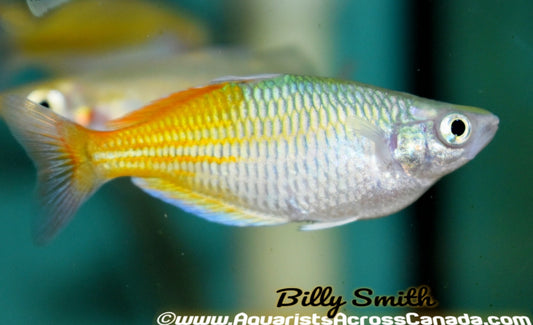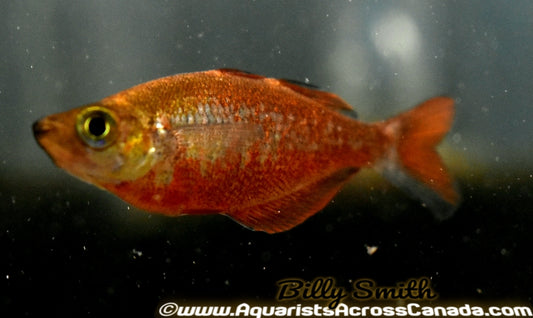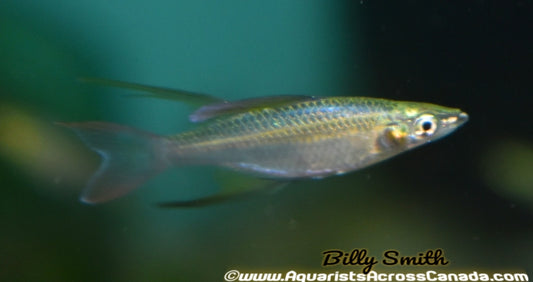Collection: Rainbowfish
NOW WHEN YOU BUY MULTIPLES OF ANY SCHOOLING FISH A TIERED DISCOUNT IS APPLIED AUTOMATICALLY TO CART.
This applies only to fish purchased online, not in store.
Rainbowfish are made up of two main groups: the Families Melanotaeniidae and Bedotiidae, which include larger active fish in the genera Melanotaenia, Glossolepis and Bedotia, the Madagascar Rainbow. (An exception is the tiny Threadfin Rainbow, I. werneri, which should be treated like a Pseudomugilid.) The Family Pseudomugilidae is comprised of smaller, more docile fish, often referred to as “Blue Eyes”. Finally, the Family Telmatherinidae includes a lone species, Marosatherina ladegesi, the Celebese Rainbow. It isn’t hard to understand how rainbowfish got their name once you see a school of brilliantly colored adult Melanotaeniids or a pair of “Blue Eyes” in full spawning dress.
Rainbowfish are native to Australia, Papua New Guinea and parts of Indonesia, where they are found in streams, rivers, lakes and swamps. Some wild rainbowfish populations have become severely threatened by human activity, as well as the introduction of invasive species. Most rainbowfish available in the hobby are produced commercially on farms in Southeast Asia and Florida.
Melanotaeniid rainbowfish are peaceful yet active, and get along with most similarly sized, non-aggressive fish. Different species can be mixed together and they can also be kept with larger tetras, peaceful barbs, rasboras, danios, catfish and even non-aggressive cichlids such as Kribensis. Pseudomugilids and Threadfin Rainbows are shoalers and should be kept in groups of 6 or more for best effect. Males will exhibit their best colors as they vie for attention from females. They are docile and sometimes shy, so tank mates should be chosen carefully. These may include pygmy rasboras, small tetras, peaceful barbs, Neocaridinia and Caridinia shrimp, Otocinclus and Corydoras catfish.
-
BOESMANI RAINBOW (Melanotaenia boesemani)
Regular price $12.99 CADRegular priceUnit price / per -
CELEBES RAINBOW (Marosatherina ladigesi) 2" LG
Regular price $9.99 CADRegular priceUnit price / per -
DWARF NEON RAINBOW (Melanotaenia praecox) 2402
Regular price $9.99 CADRegular priceUnit price / per -
FORKTAIL BLUE EYE RAINBOW (pseudomugil furcatus)
Regular price $8.99 CADRegular priceUnit price / per -
GERTRUDE RAINBOW (Pseudomugil gertrudae)
Regular price $4.99 CADRegular priceUnit price / per$5.99 CADSale price $4.99 CADSale -
IRIANI RED RAINBOW (Pseudomugil Iriani)
Regular price $14.99 CADRegular priceUnit price / per -
LAKE KUTUBU RAINBOW (Melanotaenia lacustris)
Regular price $14.99 CADRegular priceUnit price / per$14.99 CADSale price $14.99 CADSold out -
MADAGASCAN RAINBOW (Bedotia madagascarensis)
Regular price $14.99 CADRegular priceUnit price / per -
PASKA'S BLUE EYE RAINBOW "RED FORM" (pseudomugil Paskai)
Regular price $12.99 CADRegular priceUnit price / per$12.99 CADSale price $12.99 CADSold out -
RED BOESMANI RAINBOW (Melanotaenia boesemani "Aytinjo"
Regular price $24.99 CADRegular priceUnit price / per$29.99 CADSale price $24.99 CADSale -
RED IRIAN RAINBOW (Glossolepis incisus)
Regular price $12.99 CADRegular priceUnit price / per -
RED NEON BLUE EYED RAINBOW (Pseudomugil luminatus) DY2405
Regular price $11.24 CADRegular priceUnit price / per$14.99 CADSale price $11.24 CADSale -
SOUTHERN BLUE EYE RAINBOW (Pseudomugil signifer) 2404
Regular price $9.99 CADRegular priceUnit price / per -
THREADFIN RAINBOW (Iriatherina werneri) 1.25"
Regular price $8.99 CADRegular priceUnit price / per














